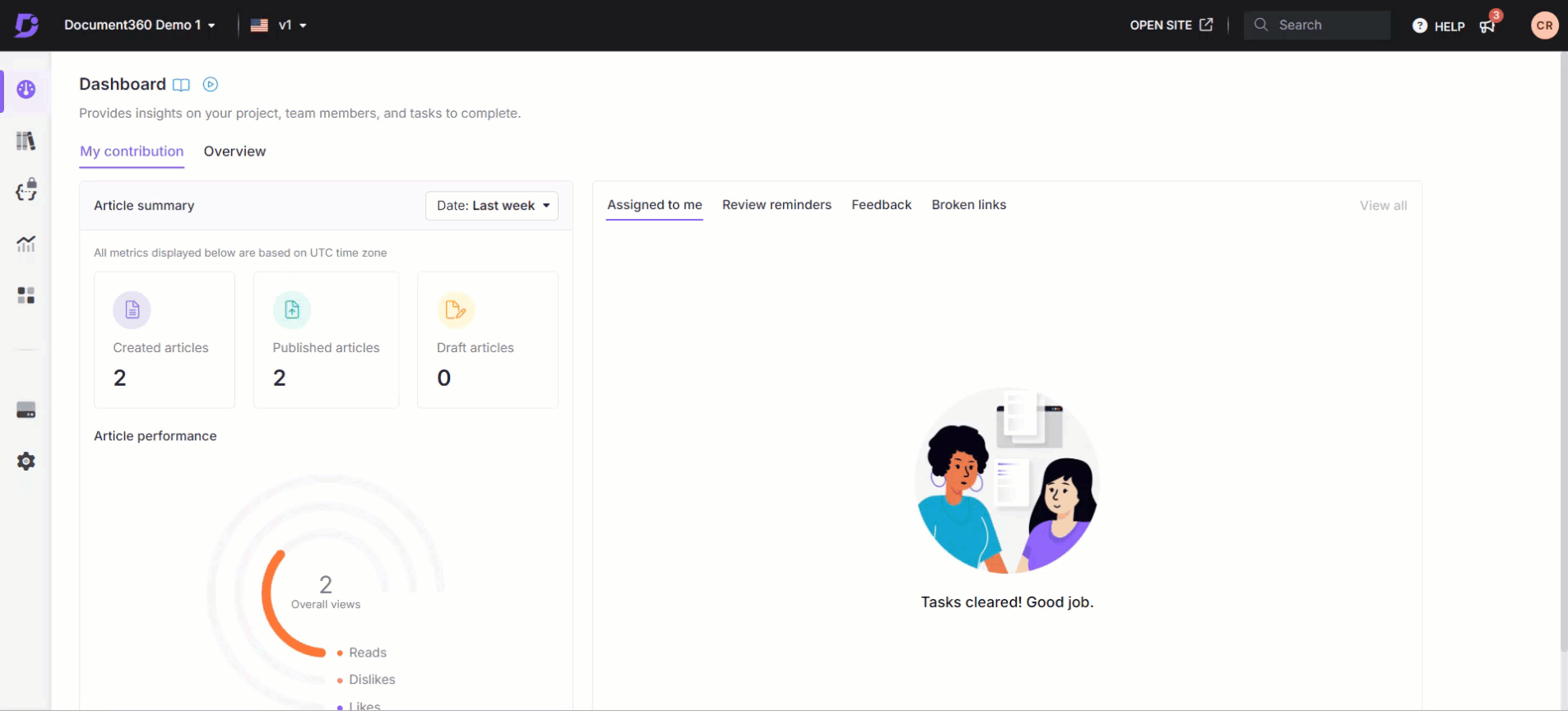Plans supporting this feature: Professional Business Enterprise
En Document360, puedes añadir varios idiomas a una sola versión del proyecto o crear un Knowledge baseespecífico de cada lenguaje.
Idiomas disponibles
Document360 soporta una variedad de idiomas para la localización utilizando la traducción automática Document360. Los idiomas soportados por Document360 son:
Lenguajes soportados
Afrikaans
Árabe
Árabe - Egipto
Búlgaro
Chino
Chino (simplificado, República Popular China)
Chino (Tradicional, Taiwán)
Chino (tradicional)
Croata
Checo
Danés
Holandés
Neerlandés (Bélgica)
Inglés
Inglés (Australia)
Inglés (Reino Unido)
Inglés (EE. UU.)
Estonio
Fiyiano
Filipino
Finlandés
Francés
Francés (Canadá)
Georgiano
Alemán
Griego
Griego (Grecia)
He - עִבְרִית
Húngaro
Islandés
Indonesio
Italiano
Ja - 日本語
Coreano
Kurdo
Letón
Lituano
Malgache
Mongol
Noruego
Persa
Polaco
Portugués
Portugués (Brasil)
Punjabí
Rumano
Eslovaco
Esloveno
Español
Español (México)
Sueco
Tailandés
Türkçe
Ucraniano
Vietnamita
Русский
Añadir varios idiomas a una sola versión
Navega hasta Configuración () en la barra de navegación izquierda del portal de la base de conocimiento.
En el panel de navegación izquierdo, navega hasta Portal de la base de conocimientos > Localización y espacios de trabajo.
En la pestaña Localización y Espacios de Trabajo , puedes encontrar la lista de versiones disponibles en el proyecto.
Hay dos formas de añadir un nuevo lenguaje a la versión del proyecto.
Método 1
Haz clic en Editar (🖉) a la derecha y aparece el panel de Editar espacio de trabajo .
Haz clic en el desplegable de nuevo idioma y aparece una lista de idiomas.
Introduce el idioma o palabra clave deseada en el campo de Lenguas de búsqueda y el resultado se llena.
Selecciona la casilla para el(los) idioma(s) deseado(s) y haz clic en Aplicar.
Una vez terminado, haz clic en Actualizar en la parte inferior del panel.
Para más configuraciones relacionadas con un idioma, también puedes usar Más opciones (•••) adyacentes al nombre del idioma.
Definido como predeterminado: Selecciona esta opción para establecer el idioma correspondiente como el idioma predeterminado para tu base de conocimientos.
Editar nombre de visualización: Utiliza esta opción para actualizar el nombre de visualización de tu espacio de trabajo. El nombre actualizado se mostrará en la página de la base de conocimientos cuando se seleccione el idioma correspondiente. Puedes establecer un nombre de visualización personalizado para tu espacio de trabajo en cada uno de los idiomas disponibles.
De derecha a izquierda: La mayoría de los idiomas se escriben de izquierda a derecha. Sin embargo, hay un puñado de lenguas escritas en sentido contrario. Al habilitar esto, el contenido del artículo en la vista del editor HTML y del lector (Knowledge base site) comenzaría a la derecha y terminaría a la izquierda.
NOTA
Idiomas como el chino, japonés y coreano siguen sus respectivas convenciones nativas de diseño de texto y se renderizan correctamente en la base de conocimientos cuando corresponde.
Ocultar: Oculta el idioma de la base de conocimientos. Los idiomas ocultos se indican mediante tachaduras en el portal de la base de conocimiento para referencia.
Eliminar: Eliminar el idioma de la lista seleccionada.
NOTA
No puedes ocultar ni borrar un idioma por defecto.
.gif)
Método 2
Haz clic en Añadir nuevo idioma() junto al icono de Editar (🖉).
Selecciona la casilla para el(los) idioma(s) deseado(s) y haz clic en Añadir.
Introduce el idioma o palabra clave deseada en el campo Filtrar idiomas y el resultado se rellena.
Todas las categorías y artículos de tu idioma predeterminado están disponibles en el/los nuevo idioma(s). Sin embargo, estos artículos y categorías deben traducirse manualmente usando traducción automática (solo editor HTML) o con extensiones como Crowdin.

NOTA
Al seleccionar un idioma para tu espacio de trabajo, todos los idiomas que no sean el inglés se mostrarán en su escritura nativa.
Preguntas más frecuentes
¿Por qué el contenido de algunos artículos publicados en el idioma predeterminado no aparece en el editor del mismo artículo en el idioma secundario?
Cuando se crea un nuevo artículo y se añade contenido en el idioma por defecto, el artículo aparecerá en el idioma secundario, pero el contenido no se trasladará automáticamente. Para traducir el contenido, utiliza la sección Todos los artículos para traducir los artículos en masa del idioma por defecto al segundo idioma.